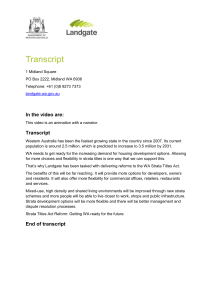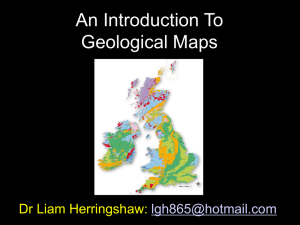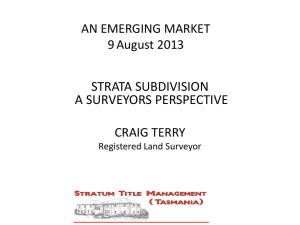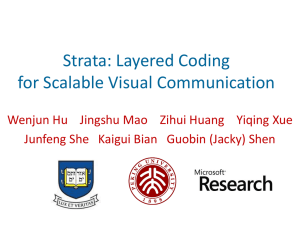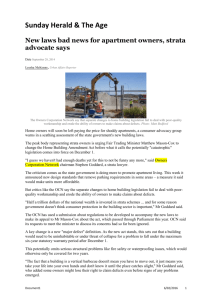hstm_workshop_2_summary - Pacific Northwest Aquatic
advertisement
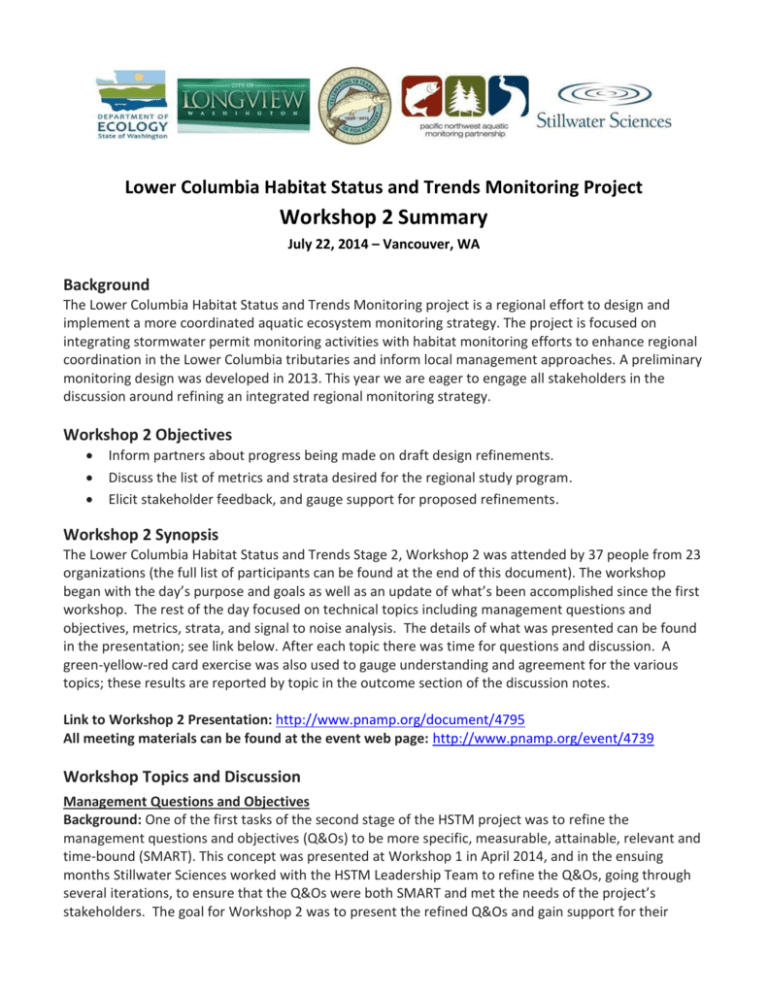
Lower Columbia Habitat Status and Trends Monitoring Project Workshop 2 Summary July 22, 2014 – Vancouver, WA Background The Lower Columbia Habitat Status and Trends Monitoring project is a regional effort to design and implement a more coordinated aquatic ecosystem monitoring strategy. The project is focused on integrating stormwater permit monitoring activities with habitat monitoring efforts to enhance regional coordination in the Lower Columbia tributaries and inform local management approaches. A preliminary monitoring design was developed in 2013. This year we are eager to engage all stakeholders in the discussion around refining an integrated regional monitoring strategy. Workshop 2 Objectives Inform partners about progress being made on draft design refinements. Discuss the list of metrics and strata desired for the regional study program. Elicit stakeholder feedback, and gauge support for proposed refinements. Workshop 2 Synopsis The Lower Columbia Habitat Status and Trends Stage 2, Workshop 2 was attended by 37 people from 23 organizations (the full list of participants can be found at the end of this document). The workshop began with the day’s purpose and goals as well as an update of what’s been accomplished since the first workshop. The rest of the day focused on technical topics including management questions and objectives, metrics, strata, and signal to noise analysis. The details of what was presented can be found in the presentation; see link below. After each topic there was time for questions and discussion. A green-yellow-red card exercise was also used to gauge understanding and agreement for the various topics; these results are reported by topic in the outcome section of the discussion notes. Link to Workshop 2 Presentation: http://www.pnamp.org/document/4795 All meeting materials can be found at the event web page: http://www.pnamp.org/event/4739 Workshop Topics and Discussion Management Questions and Objectives Background: One of the first tasks of the second stage of the HSTM project was to refine the management questions and objectives (Q&Os) to be more specific, measurable, attainable, relevant and time-bound (SMART). This concept was presented at Workshop 1 in April 2014, and in the ensuing months Stillwater Sciences worked with the HSTM Leadership Team to refine the Q&Os, going through several iterations, to ensure that the Q&Os were both SMART and met the needs of the project’s stakeholders. The goal for Workshop 2 was to present the refined Q&Os and gain support for their finalization. The Q&O document and the details of what was presented can be found by following the links above. Workshop Outcome: Most of the workshop participants indicated that they agreed with the revised management questions and objectives, a few indicated that they had minor concerns, and no one objected to the revisions. Before the questions are finalized, the language will be modified to make it clear that non-wadeable streams are included. Further discussion is needed regarding the language for questions 7, 8, and 9. Workshop Discussion: Participant question: In the regional-scale questions and objectives you specifically call out agriculture and forestry as land use categories, but there doesn’t seem to be much emphasis on urban areas. Are you only addressing urban areas in the NPDES permit related monitoring questions and objectives? At the regional scale, the urban areas are a small percentage of the whole. To assess the conditions of urban areas will take a direct targeting of those areas. It made more sense to call out the land uses with the greatest potential effect that are most represented throughout the region. The stormwater permittees are under a different reference framework; they have a different set of boxes to check. Participant question: Does this just apply to wadeable streams? No this applies to both wadeable and non-wadeable streams, but for objectives targeting specific land use types they are all going to be wadeable; there will be a certain amount of defacto stratification. We will get more into channel size when we talk about strata. Participant question: Management questions 7, 8, and 9 address very different geographic areas. Are you going to talk more about that when you discuss the strata? The area covered in question 8 (surface waters that are being affected by stormwater discharges from urban areas within areas first developed under requirements of the 2013 MS4 permit) is a subset of the areas covered in 7 (surface waters draining subwatersheds that are primarily within the jurisdiction of NPDES stormwater permittees) and 9 (in-stream and riparian habitat primarily within the jurisdiction of NPDES stormwater permittees). There aren’t many areas that would fall into the category described in question 8; it would require non-random sampling. Many permittees have water draining into their jurisdictions from outside their area; to what degree are permittees considered responsible for water originating outside their jurisdiction? o We are working on how and where permitees could contribute to monitoring within and outside of their jurisdictions I think they are all good questions, but will you be able to answer them? Should we be separating 7 and 9? o The rational for the difference between 7 and 9 - when addressing water quality it is about the watershed, riparian condition is about who is responsible for that patch of ground, biological health involves both the watershed and the riparian. I think the key is to make the objectives permit related not permit driven. Metrics Background: Stage one of the HSTM project resulted in a recommended set of water quality and habitat metrics for the regional status and trends monitoring strategy. Depending on the resources available, it may not be feasible to include the entire list of metrics identified in stage one due to high cost. At Workshop 2, Stillwater Sciences presented their recommendations for prioritizing the list of metrics from stage one. The goal for Workshop 2 was to present the initial prioritization, solicit feedback, and discuss the process for finalizing the metrics list. Workshop Outcome: There was an even mix of workshop participants that indicated that they either understood and agreed with the information that was presented on the metrics, or that they had concerns. The next step is to conduct a signal to noise analysis to help determine the utility of the various metrics being considered; these results will help further refine their prioritization. Workshop Discussion: Presentation question: The existing network of stream gauges doesn’t seem to be sufficient to adequately cover the Lower Columbia ESU, and instantaneous measurements during monitoring surveys will have limited utility. We’re not sure how flow will be adequately measured, any thoughts from workshop participants? In Puget Sound the stream gauging network analysis found that 30 gages would provide useful information for 100 monitoring sites. The potential monitoring sites have since gone through site evaluation and about half were excluded; now that we have the confirmed site list another look at the stream gauging network will be taken. Presentation question: Do you have any feedback on the metric prioritization presented today? Relative bed stability has been used a lot over the last 10-15 years. Relative bed stability is a mulit-metric index that includes: substrate composition, gradient and others. Both Oregon DEQ and Washington Department of Ecology calculate relative bed stability. Participant comment: If this is to be an integrated strategy with the ability for organizations to share data, you need to look at the commonalities between the protocols being used. Yes this will be done, and we will touch on that later today. We certainly don’t want to be creating new methods; we are looking for ones with proven track records. Strata Background: Stage one of the HSTM project recommended a stratified probability spatial design for site selection. As described in stage one Technical Memo 3 “To focus monitoring toward answering management questions of interest, and to ensure that sites adequately represent the variability evident within the Lower Columbia Region, the region will be divided into several spatial strata and new sites will be selected relative to these strata. A stratified or variable probability sample allows for unequal probability sampling where the proportion of samples in each strata does not match the observed distribution of these strata in the population. Unequal probability sampling allows larger sample size to be allocated to strata that have high variability or are of particular interest for monitoring or resource management.” Although stage one of the project identified potential strata for water quality and habitat, it was suggested that further evaluation and vetting be done to ensure the correct strata had been identified. At Workshop 2, Stillwater Sciences presented their findings from an analysis of existing draft strata and additional strata that were not explored in Stage 1 of the HSTM Project. Their goal was to get feedback from stakeholders. Workshop Outcome: There was an even mix of workshop participants that indicated that they either understood and agreed with the information that was presented on the strata, or that they had concerns. Further work is needed before developing final recommendations regarding strata for this monitoring strategy; next steps identified during the workshop can be found in the discussion notes below. Workshop Discussion: Participant question: For water quality and water quantity are the 120 strata unique or are some encompassed within each other? There are 120 unique combinations, but not all combinations will have master sample points. In general the strata are multiplicative and have the reasonable assumption that the parameters would systematically vary across the strata. Participant question: Stratification is important and powerful, but do you really expect to see systematic differences across all of the habitat strata? Too much stratification will harm the analysis if there isn’t a real reason for doing so. Yes, we do believe that there is the potential for systematic differences. For inside/outside the NPDES boundary in particular the permittees need to be able to point to a set of sampling locations as theirs and be able to show responsiveness to management actions. o You may be able to post stratify to look at that. Participant question: Regarding the “recovery region” strata, are there different actions in the recovery plans for each region that you think will lead to different results? The main difference between recovery regions is precipitation. This strata is really more about hydrologic setting than the recovery plan actions. Participant question: In the presentation, what does EDT mean? Ecosystem Diagnosis and Treatment. It is a way to infer or project what habitat would benefit anadromous fish – i.e., anadromous fish bearing streams. Participant comment: If you are looking for ways to reduce the number of strata, because drainage area automatically stratifies with gradient you may be able to just look at high and low gradient. Yes once you get above two square kilometers the top two gradient categories don’t have representative sites, and above 10 or 20 square kilometers you only have sites in the lowest gradient category. Still think it’s worth maintaining the matrix of all combinations, but not all combinations will have representative sites. We need to keep in mind not just the physical differences but also the biological differences for fish. They will respond to relatively small differences in gradient; for Chinook a 0-1% gradient is very different than 1-2%. Participant question: What are the next steps for deciding on strata? We will solicit refinements for the categories and look to see how many points fall within the various categories, and determine the number of samples needed to fill out the framework and assess feasibility. For habitat, the issue of 25 subbasin strata categories needs to be looked at more closely. We will work with NOAA and the Oregon and Washington departments of fish and wildlife to determine if there is a management purpose for this level of stratification. We want to provide sufficient background and detail so that everyone can understand. Stillwater will work on a write-up with analysis in the next month. If time permits we may hold a teleconference discussion on the topic. Participant question: Is the intent to develop the plan and then find the partners later? It seems like we need to keep the number of strata down to keep expenses down. It is easy to include the whole kitchen sink; are there reality checks that you have used? Maybe this is an iterative process? How do we figure out who will pay for what? Stillwater is bringing their expertise, e.g., recommendations for using drainage area and determining appropriate thresholds. o 0.6 square kilometers makes sense for anadromous fish, but is that the only interest of the group? Signal to Noise Background: To help guide the selection of metrics to include in the integrated Lower Columbia monitoring strategy, a signal to noise analysis will be conducted. The analysis will include a literature review of work that has already been done looking at water quality and habitat monitoring measurements and metrics, and new analysis of data collected by existing monitoring programs in the Pacific Northwest. The analysis is intended to identify the metrics, measurements, and associated data collection methods that most accurately describe conditions for a small subset of priority metrics. The goal of Workshop 2 was to share information about the analysis and provide opportunities for questions. Workshop Discussion: Presentation question: We are looking for input on what you think are the top 2-3 priority metrics for water quality and habitat for inclusion in the signal to noise analysis. For habitat we want to make sure that we represent the limiting factors for anadromous fish. Substrate, riparian vegetation structure, habitat complexity, amount of available habitat (e.g., number of pools), shade, erosion (or bank quality or vulnerability or bank angle failure) – these are the general categories; you would need to pick specific metrics from each category. Look at the work that Robert Al-Chokhachy et al. have published. Lean on other work that has been done in this region. Could we focus on the prioritized list of parameters in Attachment A as a starting point for prioritizing Qa/Qx for signal to noise? (these are bugs, temperature, DO, zinc, copper and lead). Participant question: Can you clarify the difference between measurement and metric? A measurement is taken at one point at a site (e.g. one measurement of bankfull width). Metrics are derived, they are calculated to represent the site as a whole (e.g. the 10 individual bankfull measurements are averaged to calculated the mean bankfull width of the site). The table in the presentation showing the number of measurement and metrics that the seven ISTM programs have in common only speaks to commonalities and not to data comparability/interoperability. Participant comment: We need to be thinking about how we are going to analyze the data before we settle on the list of metrics to ensure that we can answer the questions we want answered. Need to make sure we are representing the overall variability of the landscape. I would like to see an outline of the analysis methods used to answer the different question - will it be multivariate or univariate because too many strata will make interpretation difficult. That is a very important point, but we haven’t gotten to that yet. By the next workshop we will be discussing measurements and analysis. The reason we stratify is the apples to apples and oranges to oranges comparison, which is related to how we analyze the data, but we don’t want to collect measurements in areas that are inherently different – we want to keep the signal as clear as possible. We also need to keep in mind that aside from the integrated program, data analysis will be done differently for each organization to meet their specific needs. Workshop Participants (in person and on the phone): Scott Anderson Jamie Anthony Andy Clodfelter Keith Dublanica Stephanie Miller Jennifer O'Neal Karen Adams Jennifer Bayer Derek Booth Jeff Breckel Jeff Cameron Lisa Cox Karen Dinicola Richard Dyrland Pat Frazier Nikki Guillot James Huninker Jody Lando Chad Larson Sam Lohr Brandi Lubliner Van McKay Ron Melcer Glenn Merritt Kris Olinger Wade Peerman Katie Pierson Amy Puls Tabitha Reeder Cleve Steward Dorie Sutton Rod Swanson Kelly Uhacz Ian Waite Joanne Wallis Steve Warner Jeff Wittler National Oceanic and Atmospheric Administration Oregon Department of Fish and Wildlife Hart Crowser Washington Governor's Salmon Recovery Office US Bureau of Land Management, Aquatic and Riparian Effectiveness Monitoring Program Tetra Tech, Inc. Lower Columbia Fish Recovery Board US Geological Survey, Pacific Northwest Aquatic Monitoring Partnership Stillwater Sciences Lower Columbia Fish Recovery Board City of Longview Washington Department of Ecology Washington Department of Ecology Friends of the Eastfork Lewis Lower Columbia Fish Recovery Board Washington Department of Ecology Washington Department of Natural Resources Stillwater Sciences Washington Department of Ecology US Fish and Wildlife Service Washington Department of Ecology City of Kelso Salmon Creek Watershed Council Washington Department of Ecology City of Vancouver Oregon Department of Environmental Quality US Geological Survey, Pacific Northwest Aquatic Monitoring Partnership US Geological Survey, Pacific Northwest Aquatic Monitoring Partnership Port of Kalama Hart Crowser City of Vancouver Clark County City of Battle Ground US Geological Survey US Geological Survey City of Longview Clark Public Utilities
